Detailed Analysis of IHG Hospitality Operations Management Report
VerifiedAdded on 2020/12/30
|15
|4803
|25
Report
AI Summary
This report provides a comprehensive analysis of IHG (InterContinental Hotels Group) operations management. It examines the nature of IHG's products and services, including food, beverages, and accommodation, and evaluates the impact of various factors, such as seasonality, economic conditions, and cultural influences, on customer demand. The report compares customer profiles, considering their differing expectations and spending power, and assesses the factors affecting average spending. Furthermore, it delves into the key stages of product and service development within IHG, including idea generation, concept testing, and commercialization. The report also explores pricing strategies, revenue generation, and profitability factors, along with a range of performance measures and appraisal techniques used to analyze and improve operational performance. The conclusion summarizes the key findings and recommendations for enhancing IHG's operational effectiveness.

Hospitality Operations
Management
Management
Paraphrase This Document
Need a fresh take? Get an instant paraphrase of this document with our AI Paraphraser

TABLE OF CONTENTS
INTRODUCTION...........................................................................................................................1
TASK 1............................................................................................................................................1
1.1 Nature of product and service areas offered by IHG.............................................................1
1.2 Evaluating impact of different factors on patterns of demand within hospitality operations2
1.3 Comparing the customer profiles and their differing expectations and requirements...........3
1.4 Factors affecting average spending power (ASP) in IHG.....................................................3
2.1 Assessing the key stages in product and service development applied in operations of
IHG..............................................................................................................................................4
2.2 Features contributing towards the customers’ perception of products and services.............6
2.3 Assessing impact of opportunities and constraints on product and/or service development 6
2.4 Evaluating different merchandising opportunities for products and services of IHG...........7
TASK 2............................................................................................................................................7
3.1 Assessing different methods of pricing considering additional pricing considerations........7
3.2 Evaluating factors which affect revenue generation and profitability in operations of IHG.8
TASK 3..........................................................................................................................................10
4.1 Applying a range of performance measures and appraisal techniques...........................10
4.2 Usefulness and limitations of various quantitative and qualitative appraisal techniques....10
4.3 Applying approaches to business analysis, evaluation and planning appropriate to make
proposals for action....................................................................................................................11
CONCLUSION..............................................................................................................................11
REFERENCES..............................................................................................................................13
INTRODUCTION...........................................................................................................................1
TASK 1............................................................................................................................................1
1.1 Nature of product and service areas offered by IHG.............................................................1
1.2 Evaluating impact of different factors on patterns of demand within hospitality operations2
1.3 Comparing the customer profiles and their differing expectations and requirements...........3
1.4 Factors affecting average spending power (ASP) in IHG.....................................................3
2.1 Assessing the key stages in product and service development applied in operations of
IHG..............................................................................................................................................4
2.2 Features contributing towards the customers’ perception of products and services.............6
2.3 Assessing impact of opportunities and constraints on product and/or service development 6
2.4 Evaluating different merchandising opportunities for products and services of IHG...........7
TASK 2............................................................................................................................................7
3.1 Assessing different methods of pricing considering additional pricing considerations........7
3.2 Evaluating factors which affect revenue generation and profitability in operations of IHG.8
TASK 3..........................................................................................................................................10
4.1 Applying a range of performance measures and appraisal techniques...........................10
4.2 Usefulness and limitations of various quantitative and qualitative appraisal techniques....10
4.3 Applying approaches to business analysis, evaluation and planning appropriate to make
proposals for action....................................................................................................................11
CONCLUSION..............................................................................................................................11
REFERENCES..............................................................................................................................13
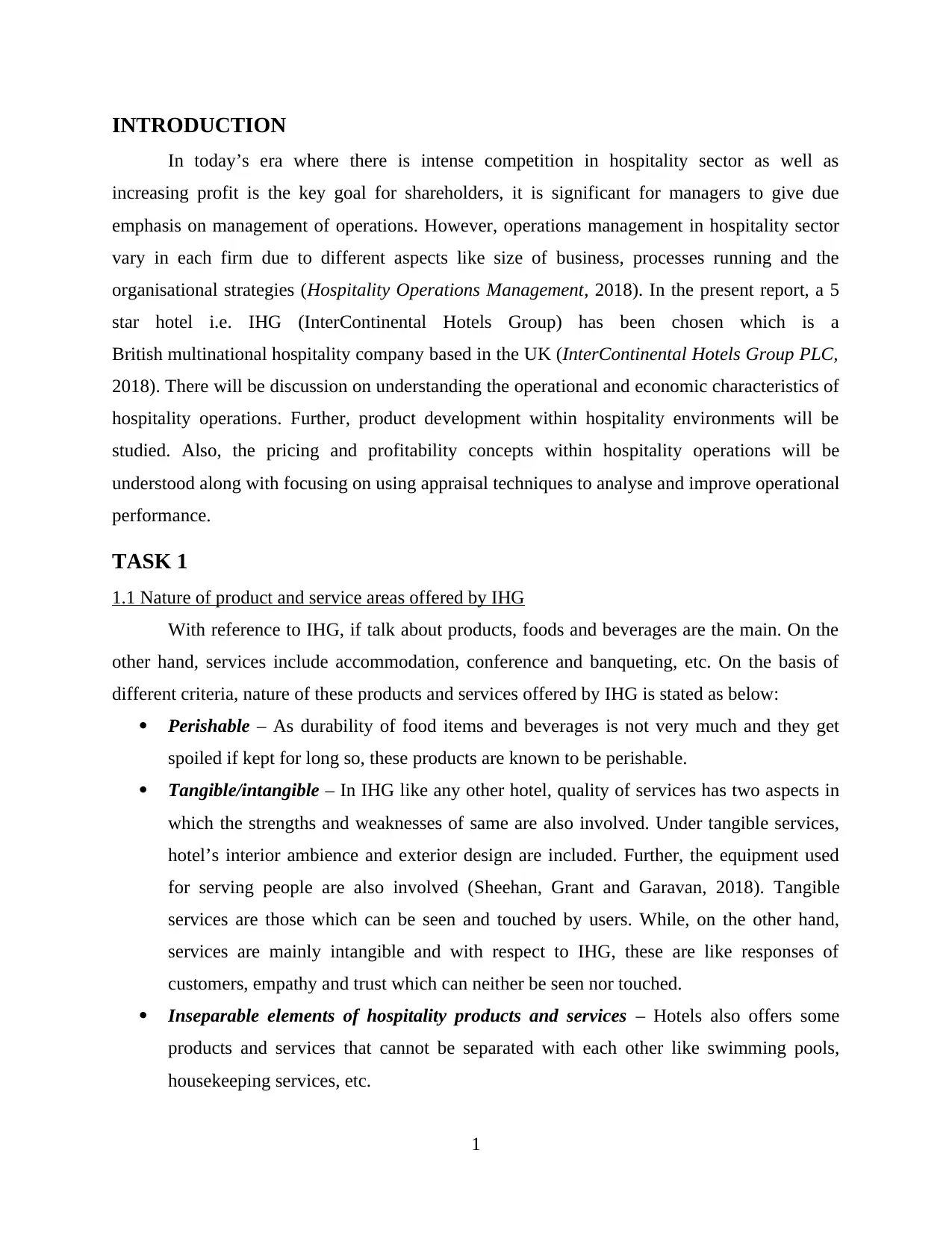
INTRODUCTION
In today’s era where there is intense competition in hospitality sector as well as
increasing profit is the key goal for shareholders, it is significant for managers to give due
emphasis on management of operations. However, operations management in hospitality sector
vary in each firm due to different aspects like size of business, processes running and the
organisational strategies (Hospitality Operations Management, 2018). In the present report, a 5
star hotel i.e. IHG (InterContinental Hotels Group) has been chosen which is a
British multinational hospitality company based in the UK (InterContinental Hotels Group PLC,
2018). There will be discussion on understanding the operational and economic characteristics of
hospitality operations. Further, product development within hospitality environments will be
studied. Also, the pricing and profitability concepts within hospitality operations will be
understood along with focusing on using appraisal techniques to analyse and improve operational
performance.
TASK 1
1.1 Nature of product and service areas offered by IHG
With reference to IHG, if talk about products, foods and beverages are the main. On the
other hand, services include accommodation, conference and banqueting, etc. On the basis of
different criteria, nature of these products and services offered by IHG is stated as below:
Perishable – As durability of food items and beverages is not very much and they get
spoiled if kept for long so, these products are known to be perishable.
Tangible/intangible – In IHG like any other hotel, quality of services has two aspects in
which the strengths and weaknesses of same are also involved. Under tangible services,
hotel’s interior ambience and exterior design are included. Further, the equipment used
for serving people are also involved (Sheehan, Grant and Garavan, 2018). Tangible
services are those which can be seen and touched by users. While, on the other hand,
services are mainly intangible and with respect to IHG, these are like responses of
customers, empathy and trust which can neither be seen nor touched.
Inseparable elements of hospitality products and services – Hotels also offers some
products and services that cannot be separated with each other like swimming pools,
housekeeping services, etc.
1
In today’s era where there is intense competition in hospitality sector as well as
increasing profit is the key goal for shareholders, it is significant for managers to give due
emphasis on management of operations. However, operations management in hospitality sector
vary in each firm due to different aspects like size of business, processes running and the
organisational strategies (Hospitality Operations Management, 2018). In the present report, a 5
star hotel i.e. IHG (InterContinental Hotels Group) has been chosen which is a
British multinational hospitality company based in the UK (InterContinental Hotels Group PLC,
2018). There will be discussion on understanding the operational and economic characteristics of
hospitality operations. Further, product development within hospitality environments will be
studied. Also, the pricing and profitability concepts within hospitality operations will be
understood along with focusing on using appraisal techniques to analyse and improve operational
performance.
TASK 1
1.1 Nature of product and service areas offered by IHG
With reference to IHG, if talk about products, foods and beverages are the main. On the
other hand, services include accommodation, conference and banqueting, etc. On the basis of
different criteria, nature of these products and services offered by IHG is stated as below:
Perishable – As durability of food items and beverages is not very much and they get
spoiled if kept for long so, these products are known to be perishable.
Tangible/intangible – In IHG like any other hotel, quality of services has two aspects in
which the strengths and weaknesses of same are also involved. Under tangible services,
hotel’s interior ambience and exterior design are included. Further, the equipment used
for serving people are also involved (Sheehan, Grant and Garavan, 2018). Tangible
services are those which can be seen and touched by users. While, on the other hand,
services are mainly intangible and with respect to IHG, these are like responses of
customers, empathy and trust which can neither be seen nor touched.
Inseparable elements of hospitality products and services – Hotels also offers some
products and services that cannot be separated with each other like swimming pools,
housekeeping services, etc.
1
⊘ This is a preview!⊘
Do you want full access?
Subscribe today to unlock all pages.

Trusted by 1+ million students worldwide
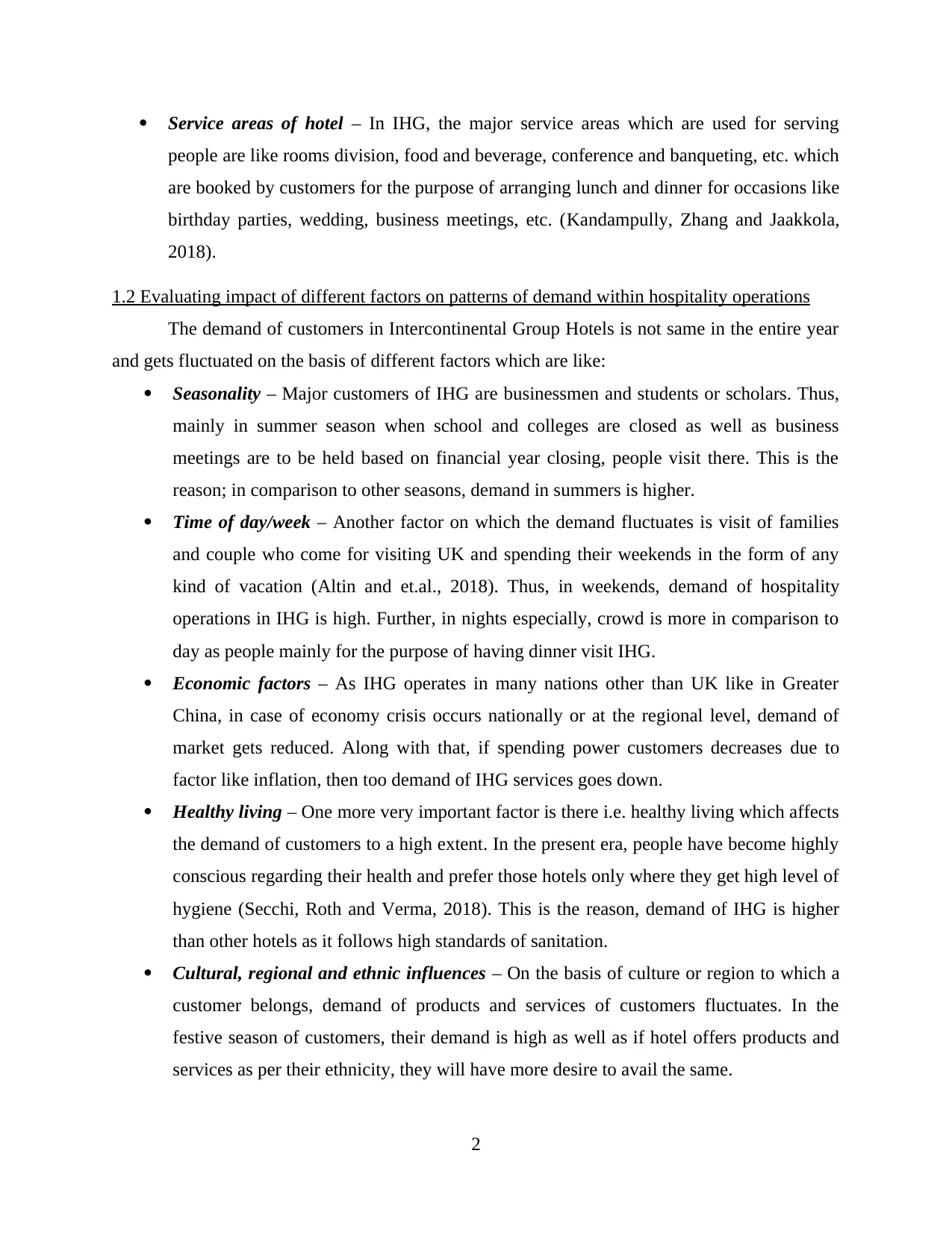
Service areas of hotel – In IHG, the major service areas which are used for serving
people are like rooms division, food and beverage, conference and banqueting, etc. which
are booked by customers for the purpose of arranging lunch and dinner for occasions like
birthday parties, wedding, business meetings, etc. (Kandampully, Zhang and Jaakkola,
2018).
1.2 Evaluating impact of different factors on patterns of demand within hospitality operations
The demand of customers in Intercontinental Group Hotels is not same in the entire year
and gets fluctuated on the basis of different factors which are like:
Seasonality – Major customers of IHG are businessmen and students or scholars. Thus,
mainly in summer season when school and colleges are closed as well as business
meetings are to be held based on financial year closing, people visit there. This is the
reason; in comparison to other seasons, demand in summers is higher.
Time of day/week – Another factor on which the demand fluctuates is visit of families
and couple who come for visiting UK and spending their weekends in the form of any
kind of vacation (Altin and et.al., 2018). Thus, in weekends, demand of hospitality
operations in IHG is high. Further, in nights especially, crowd is more in comparison to
day as people mainly for the purpose of having dinner visit IHG.
Economic factors – As IHG operates in many nations other than UK like in Greater
China, in case of economy crisis occurs nationally or at the regional level, demand of
market gets reduced. Along with that, if spending power customers decreases due to
factor like inflation, then too demand of IHG services goes down.
Healthy living – One more very important factor is there i.e. healthy living which affects
the demand of customers to a high extent. In the present era, people have become highly
conscious regarding their health and prefer those hotels only where they get high level of
hygiene (Secchi, Roth and Verma, 2018). This is the reason, demand of IHG is higher
than other hotels as it follows high standards of sanitation.
Cultural, regional and ethnic influences – On the basis of culture or region to which a
customer belongs, demand of products and services of customers fluctuates. In the
festive season of customers, their demand is high as well as if hotel offers products and
services as per their ethnicity, they will have more desire to avail the same.
2
people are like rooms division, food and beverage, conference and banqueting, etc. which
are booked by customers for the purpose of arranging lunch and dinner for occasions like
birthday parties, wedding, business meetings, etc. (Kandampully, Zhang and Jaakkola,
2018).
1.2 Evaluating impact of different factors on patterns of demand within hospitality operations
The demand of customers in Intercontinental Group Hotels is not same in the entire year
and gets fluctuated on the basis of different factors which are like:
Seasonality – Major customers of IHG are businessmen and students or scholars. Thus,
mainly in summer season when school and colleges are closed as well as business
meetings are to be held based on financial year closing, people visit there. This is the
reason; in comparison to other seasons, demand in summers is higher.
Time of day/week – Another factor on which the demand fluctuates is visit of families
and couple who come for visiting UK and spending their weekends in the form of any
kind of vacation (Altin and et.al., 2018). Thus, in weekends, demand of hospitality
operations in IHG is high. Further, in nights especially, crowd is more in comparison to
day as people mainly for the purpose of having dinner visit IHG.
Economic factors – As IHG operates in many nations other than UK like in Greater
China, in case of economy crisis occurs nationally or at the regional level, demand of
market gets reduced. Along with that, if spending power customers decreases due to
factor like inflation, then too demand of IHG services goes down.
Healthy living – One more very important factor is there i.e. healthy living which affects
the demand of customers to a high extent. In the present era, people have become highly
conscious regarding their health and prefer those hotels only where they get high level of
hygiene (Secchi, Roth and Verma, 2018). This is the reason, demand of IHG is higher
than other hotels as it follows high standards of sanitation.
Cultural, regional and ethnic influences – On the basis of culture or region to which a
customer belongs, demand of products and services of customers fluctuates. In the
festive season of customers, their demand is high as well as if hotel offers products and
services as per their ethnicity, they will have more desire to avail the same.
2
Paraphrase This Document
Need a fresh take? Get an instant paraphrase of this document with our AI Paraphraser
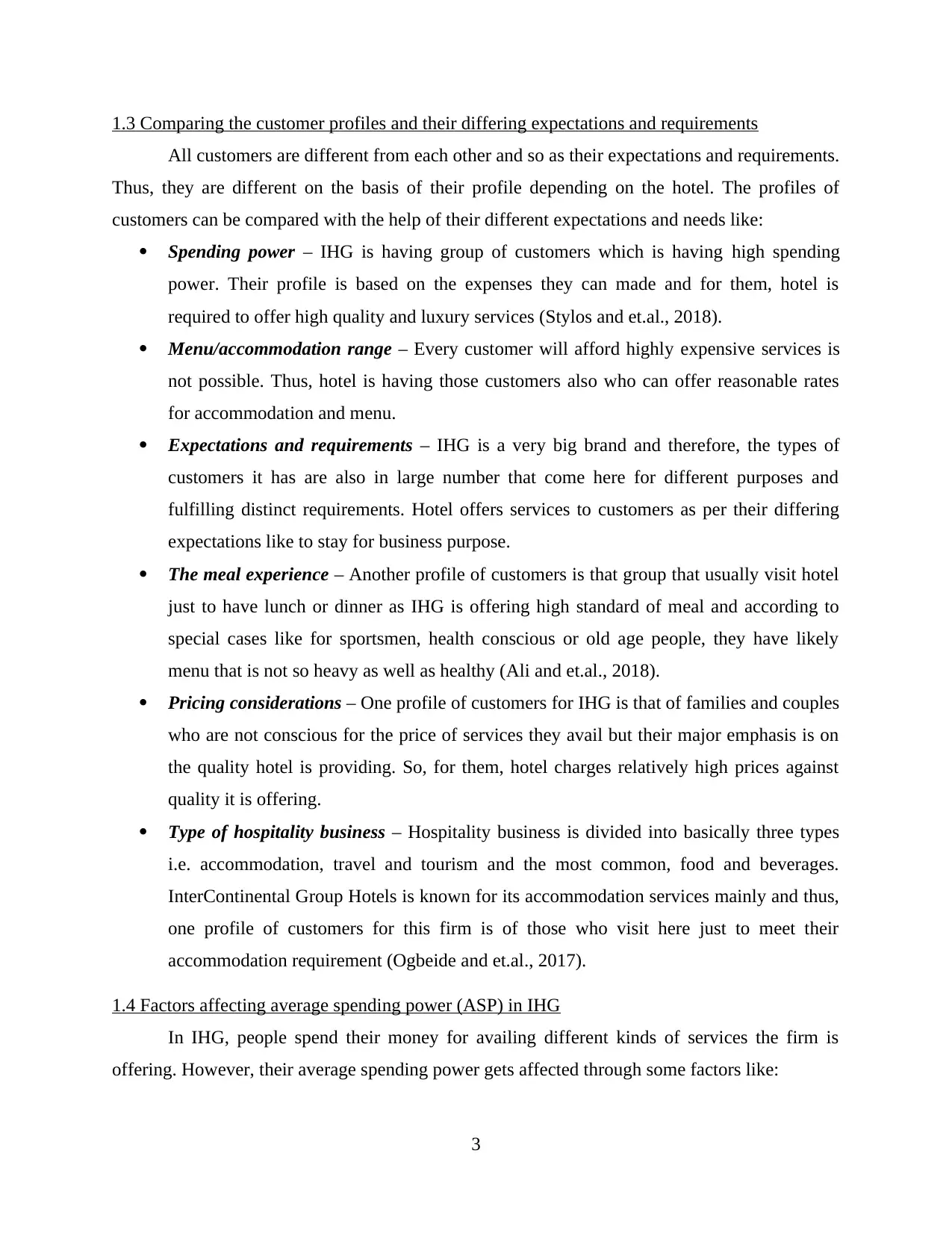
1.3 Comparing the customer profiles and their differing expectations and requirements
All customers are different from each other and so as their expectations and requirements.
Thus, they are different on the basis of their profile depending on the hotel. The profiles of
customers can be compared with the help of their different expectations and needs like:
Spending power – IHG is having group of customers which is having high spending
power. Their profile is based on the expenses they can made and for them, hotel is
required to offer high quality and luxury services (Stylos and et.al., 2018).
Menu/accommodation range – Every customer will afford highly expensive services is
not possible. Thus, hotel is having those customers also who can offer reasonable rates
for accommodation and menu.
Expectations and requirements – IHG is a very big brand and therefore, the types of
customers it has are also in large number that come here for different purposes and
fulfilling distinct requirements. Hotel offers services to customers as per their differing
expectations like to stay for business purpose.
The meal experience – Another profile of customers is that group that usually visit hotel
just to have lunch or dinner as IHG is offering high standard of meal and according to
special cases like for sportsmen, health conscious or old age people, they have likely
menu that is not so heavy as well as healthy (Ali and et.al., 2018).
Pricing considerations – One profile of customers for IHG is that of families and couples
who are not conscious for the price of services they avail but their major emphasis is on
the quality hotel is providing. So, for them, hotel charges relatively high prices against
quality it is offering.
Type of hospitality business – Hospitality business is divided into basically three types
i.e. accommodation, travel and tourism and the most common, food and beverages.
InterContinental Group Hotels is known for its accommodation services mainly and thus,
one profile of customers for this firm is of those who visit here just to meet their
accommodation requirement (Ogbeide and et.al., 2017).
1.4 Factors affecting average spending power (ASP) in IHG
In IHG, people spend their money for availing different kinds of services the firm is
offering. However, their average spending power gets affected through some factors like:
3
All customers are different from each other and so as their expectations and requirements.
Thus, they are different on the basis of their profile depending on the hotel. The profiles of
customers can be compared with the help of their different expectations and needs like:
Spending power – IHG is having group of customers which is having high spending
power. Their profile is based on the expenses they can made and for them, hotel is
required to offer high quality and luxury services (Stylos and et.al., 2018).
Menu/accommodation range – Every customer will afford highly expensive services is
not possible. Thus, hotel is having those customers also who can offer reasonable rates
for accommodation and menu.
Expectations and requirements – IHG is a very big brand and therefore, the types of
customers it has are also in large number that come here for different purposes and
fulfilling distinct requirements. Hotel offers services to customers as per their differing
expectations like to stay for business purpose.
The meal experience – Another profile of customers is that group that usually visit hotel
just to have lunch or dinner as IHG is offering high standard of meal and according to
special cases like for sportsmen, health conscious or old age people, they have likely
menu that is not so heavy as well as healthy (Ali and et.al., 2018).
Pricing considerations – One profile of customers for IHG is that of families and couples
who are not conscious for the price of services they avail but their major emphasis is on
the quality hotel is providing. So, for them, hotel charges relatively high prices against
quality it is offering.
Type of hospitality business – Hospitality business is divided into basically three types
i.e. accommodation, travel and tourism and the most common, food and beverages.
InterContinental Group Hotels is known for its accommodation services mainly and thus,
one profile of customers for this firm is of those who visit here just to meet their
accommodation requirement (Ogbeide and et.al., 2017).
1.4 Factors affecting average spending power (ASP) in IHG
In IHG, people spend their money for availing different kinds of services the firm is
offering. However, their average spending power gets affected through some factors like:
3
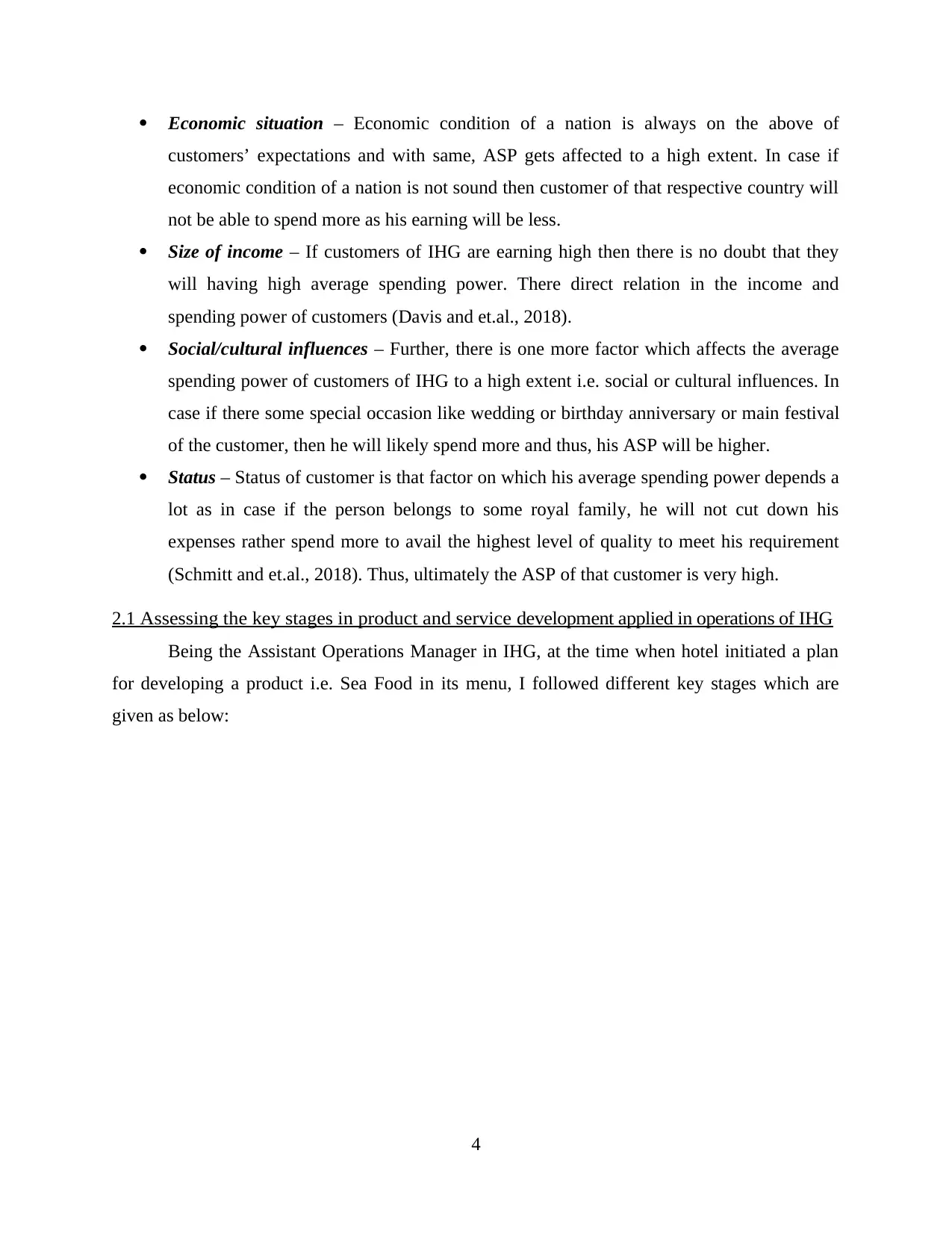
Economic situation – Economic condition of a nation is always on the above of
customers’ expectations and with same, ASP gets affected to a high extent. In case if
economic condition of a nation is not sound then customer of that respective country will
not be able to spend more as his earning will be less.
Size of income – If customers of IHG are earning high then there is no doubt that they
will having high average spending power. There direct relation in the income and
spending power of customers (Davis and et.al., 2018).
Social/cultural influences – Further, there is one more factor which affects the average
spending power of customers of IHG to a high extent i.e. social or cultural influences. In
case if there some special occasion like wedding or birthday anniversary or main festival
of the customer, then he will likely spend more and thus, his ASP will be higher.
Status – Status of customer is that factor on which his average spending power depends a
lot as in case if the person belongs to some royal family, he will not cut down his
expenses rather spend more to avail the highest level of quality to meet his requirement
(Schmitt and et.al., 2018). Thus, ultimately the ASP of that customer is very high.
2.1 Assessing the key stages in product and service development applied in operations of IHG
Being the Assistant Operations Manager in IHG, at the time when hotel initiated a plan
for developing a product i.e. Sea Food in its menu, I followed different key stages which are
given as below:
4
customers’ expectations and with same, ASP gets affected to a high extent. In case if
economic condition of a nation is not sound then customer of that respective country will
not be able to spend more as his earning will be less.
Size of income – If customers of IHG are earning high then there is no doubt that they
will having high average spending power. There direct relation in the income and
spending power of customers (Davis and et.al., 2018).
Social/cultural influences – Further, there is one more factor which affects the average
spending power of customers of IHG to a high extent i.e. social or cultural influences. In
case if there some special occasion like wedding or birthday anniversary or main festival
of the customer, then he will likely spend more and thus, his ASP will be higher.
Status – Status of customer is that factor on which his average spending power depends a
lot as in case if the person belongs to some royal family, he will not cut down his
expenses rather spend more to avail the highest level of quality to meet his requirement
(Schmitt and et.al., 2018). Thus, ultimately the ASP of that customer is very high.
2.1 Assessing the key stages in product and service development applied in operations of IHG
Being the Assistant Operations Manager in IHG, at the time when hotel initiated a plan
for developing a product i.e. Sea Food in its menu, I followed different key stages which are
given as below:
4
⊘ This is a preview!⊘
Do you want full access?
Subscribe today to unlock all pages.

Trusted by 1+ million students worldwide
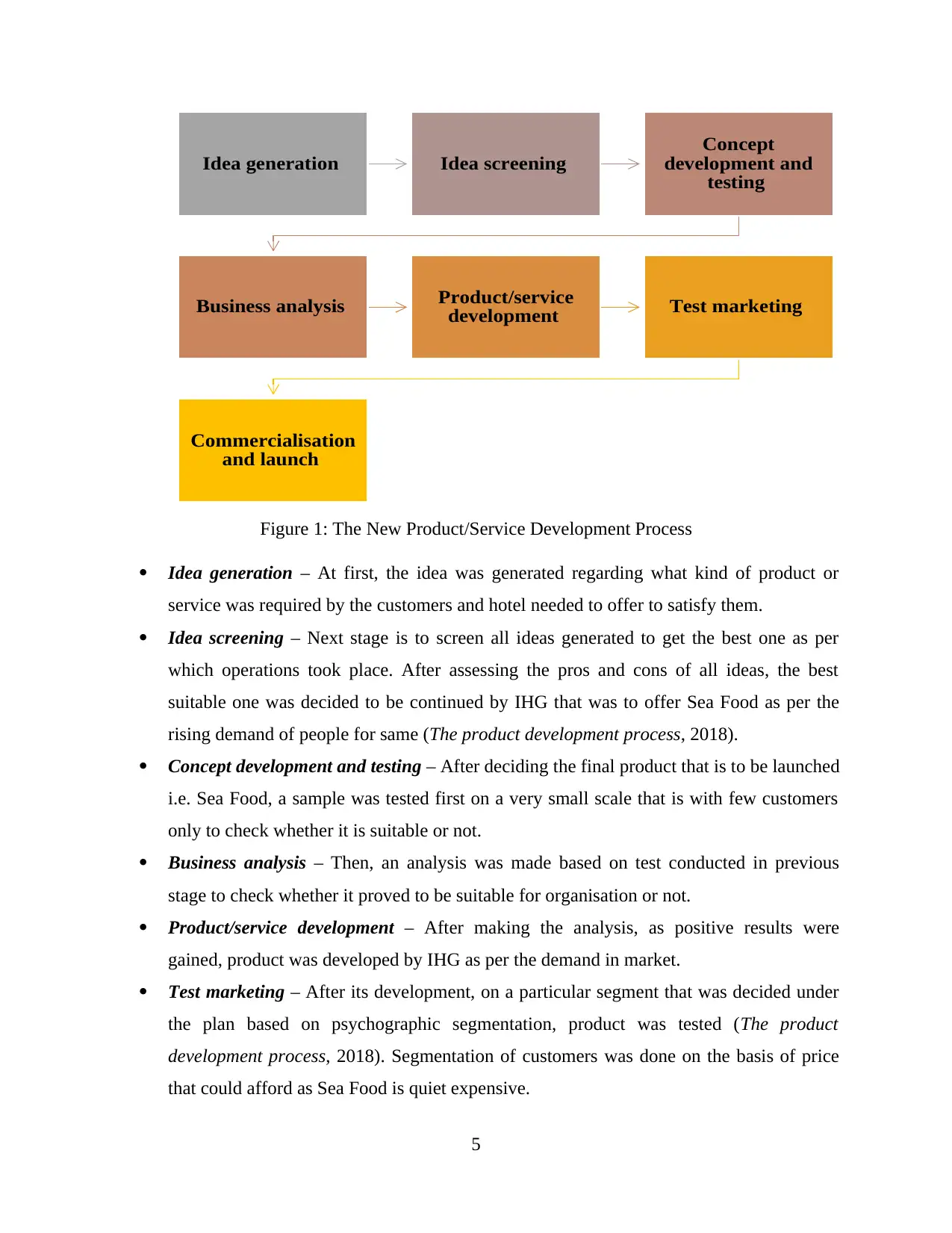
Figure 1: The New Product/Service Development Process
Idea generation – At first, the idea was generated regarding what kind of product or
service was required by the customers and hotel needed to offer to satisfy them.
Idea screening – Next stage is to screen all ideas generated to get the best one as per
which operations took place. After assessing the pros and cons of all ideas, the best
suitable one was decided to be continued by IHG that was to offer Sea Food as per the
rising demand of people for same (The product development process, 2018).
Concept development and testing – After deciding the final product that is to be launched
i.e. Sea Food, a sample was tested first on a very small scale that is with few customers
only to check whether it is suitable or not.
Business analysis – Then, an analysis was made based on test conducted in previous
stage to check whether it proved to be suitable for organisation or not.
Product/service development – After making the analysis, as positive results were
gained, product was developed by IHG as per the demand in market.
Test marketing – After its development, on a particular segment that was decided under
the plan based on psychographic segmentation, product was tested (The product
development process, 2018). Segmentation of customers was done on the basis of price
that could afford as Sea Food is quiet expensive.
5
Idea generation Idea screening
Concept
development and
testing
Business analysis Product/service
development Test marketing
Commercialisation
and launch
Idea generation – At first, the idea was generated regarding what kind of product or
service was required by the customers and hotel needed to offer to satisfy them.
Idea screening – Next stage is to screen all ideas generated to get the best one as per
which operations took place. After assessing the pros and cons of all ideas, the best
suitable one was decided to be continued by IHG that was to offer Sea Food as per the
rising demand of people for same (The product development process, 2018).
Concept development and testing – After deciding the final product that is to be launched
i.e. Sea Food, a sample was tested first on a very small scale that is with few customers
only to check whether it is suitable or not.
Business analysis – Then, an analysis was made based on test conducted in previous
stage to check whether it proved to be suitable for organisation or not.
Product/service development – After making the analysis, as positive results were
gained, product was developed by IHG as per the demand in market.
Test marketing – After its development, on a particular segment that was decided under
the plan based on psychographic segmentation, product was tested (The product
development process, 2018). Segmentation of customers was done on the basis of price
that could afford as Sea Food is quiet expensive.
5
Idea generation Idea screening
Concept
development and
testing
Business analysis Product/service
development Test marketing
Commercialisation
and launch
Paraphrase This Document
Need a fresh take? Get an instant paraphrase of this document with our AI Paraphraser
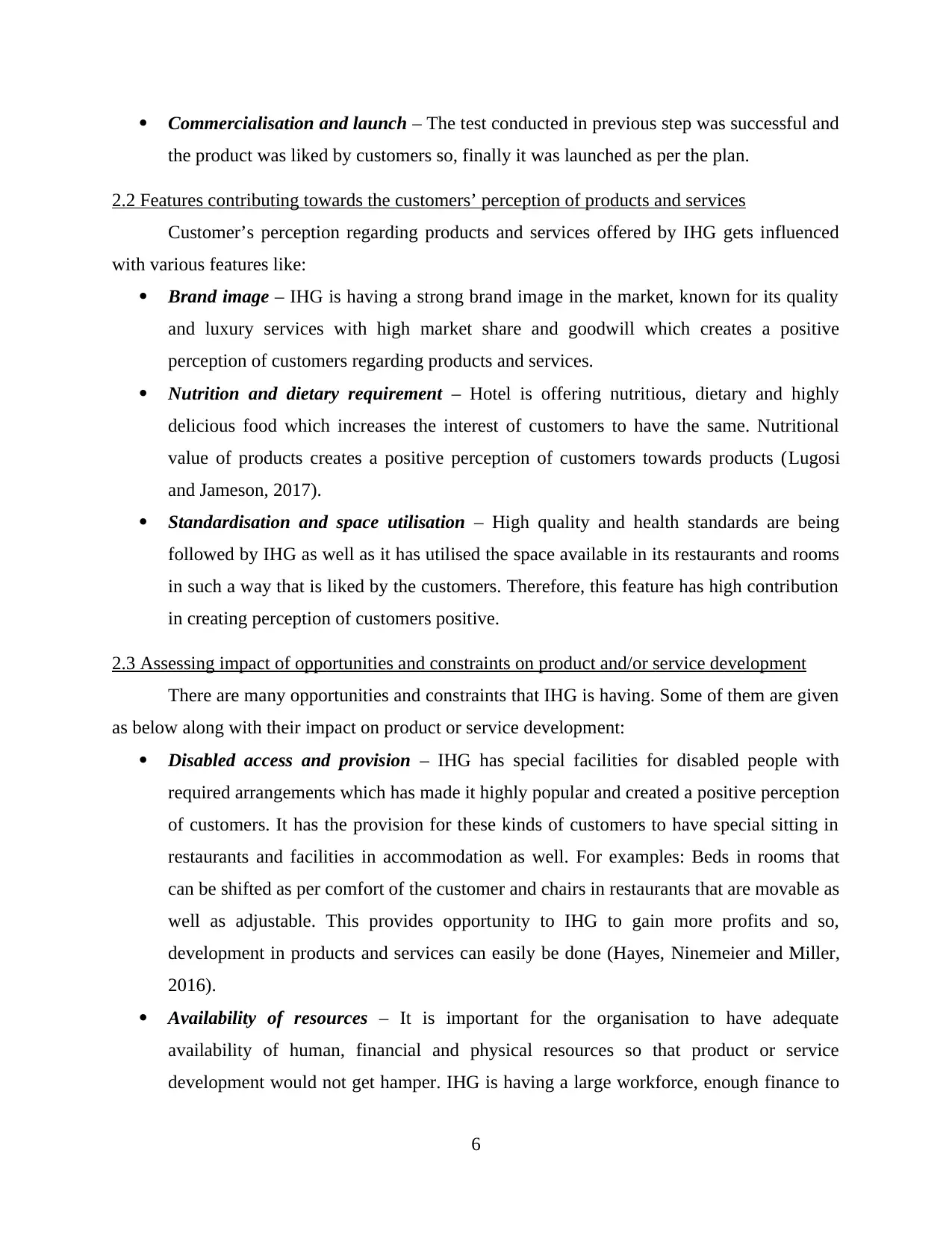
Commercialisation and launch – The test conducted in previous step was successful and
the product was liked by customers so, finally it was launched as per the plan.
2.2 Features contributing towards the customers’ perception of products and services
Customer’s perception regarding products and services offered by IHG gets influenced
with various features like:
Brand image – IHG is having a strong brand image in the market, known for its quality
and luxury services with high market share and goodwill which creates a positive
perception of customers regarding products and services.
Nutrition and dietary requirement – Hotel is offering nutritious, dietary and highly
delicious food which increases the interest of customers to have the same. Nutritional
value of products creates a positive perception of customers towards products (Lugosi
and Jameson, 2017).
Standardisation and space utilisation – High quality and health standards are being
followed by IHG as well as it has utilised the space available in its restaurants and rooms
in such a way that is liked by the customers. Therefore, this feature has high contribution
in creating perception of customers positive.
2.3 Assessing impact of opportunities and constraints on product and/or service development
There are many opportunities and constraints that IHG is having. Some of them are given
as below along with their impact on product or service development:
Disabled access and provision – IHG has special facilities for disabled people with
required arrangements which has made it highly popular and created a positive perception
of customers. It has the provision for these kinds of customers to have special sitting in
restaurants and facilities in accommodation as well. For examples: Beds in rooms that
can be shifted as per comfort of the customer and chairs in restaurants that are movable as
well as adjustable. This provides opportunity to IHG to gain more profits and so,
development in products and services can easily be done (Hayes, Ninemeier and Miller,
2016).
Availability of resources – It is important for the organisation to have adequate
availability of human, financial and physical resources so that product or service
development would not get hamper. IHG is having a large workforce, enough finance to
6
the product was liked by customers so, finally it was launched as per the plan.
2.2 Features contributing towards the customers’ perception of products and services
Customer’s perception regarding products and services offered by IHG gets influenced
with various features like:
Brand image – IHG is having a strong brand image in the market, known for its quality
and luxury services with high market share and goodwill which creates a positive
perception of customers regarding products and services.
Nutrition and dietary requirement – Hotel is offering nutritious, dietary and highly
delicious food which increases the interest of customers to have the same. Nutritional
value of products creates a positive perception of customers towards products (Lugosi
and Jameson, 2017).
Standardisation and space utilisation – High quality and health standards are being
followed by IHG as well as it has utilised the space available in its restaurants and rooms
in such a way that is liked by the customers. Therefore, this feature has high contribution
in creating perception of customers positive.
2.3 Assessing impact of opportunities and constraints on product and/or service development
There are many opportunities and constraints that IHG is having. Some of them are given
as below along with their impact on product or service development:
Disabled access and provision – IHG has special facilities for disabled people with
required arrangements which has made it highly popular and created a positive perception
of customers. It has the provision for these kinds of customers to have special sitting in
restaurants and facilities in accommodation as well. For examples: Beds in rooms that
can be shifted as per comfort of the customer and chairs in restaurants that are movable as
well as adjustable. This provides opportunity to IHG to gain more profits and so,
development in products and services can easily be done (Hayes, Ninemeier and Miller,
2016).
Availability of resources – It is important for the organisation to have adequate
availability of human, financial and physical resources so that product or service
development would not get hamper. IHG is having a large workforce, enough finance to
6
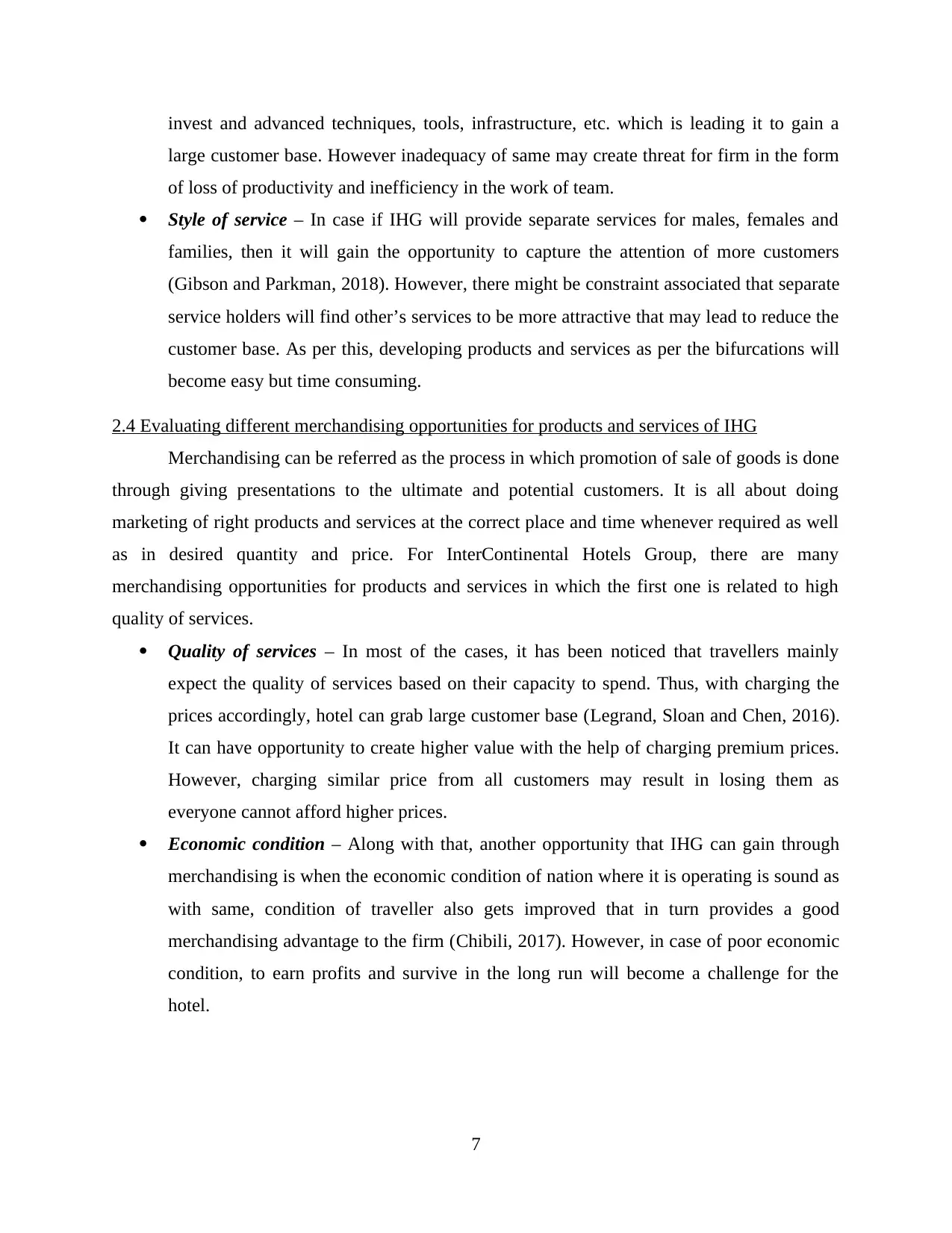
invest and advanced techniques, tools, infrastructure, etc. which is leading it to gain a
large customer base. However inadequacy of same may create threat for firm in the form
of loss of productivity and inefficiency in the work of team.
Style of service – In case if IHG will provide separate services for males, females and
families, then it will gain the opportunity to capture the attention of more customers
(Gibson and Parkman, 2018). However, there might be constraint associated that separate
service holders will find other’s services to be more attractive that may lead to reduce the
customer base. As per this, developing products and services as per the bifurcations will
become easy but time consuming.
2.4 Evaluating different merchandising opportunities for products and services of IHG
Merchandising can be referred as the process in which promotion of sale of goods is done
through giving presentations to the ultimate and potential customers. It is all about doing
marketing of right products and services at the correct place and time whenever required as well
as in desired quantity and price. For InterContinental Hotels Group, there are many
merchandising opportunities for products and services in which the first one is related to high
quality of services.
Quality of services – In most of the cases, it has been noticed that travellers mainly
expect the quality of services based on their capacity to spend. Thus, with charging the
prices accordingly, hotel can grab large customer base (Legrand, Sloan and Chen, 2016).
It can have opportunity to create higher value with the help of charging premium prices.
However, charging similar price from all customers may result in losing them as
everyone cannot afford higher prices.
Economic condition – Along with that, another opportunity that IHG can gain through
merchandising is when the economic condition of nation where it is operating is sound as
with same, condition of traveller also gets improved that in turn provides a good
merchandising advantage to the firm (Chibili, 2017). However, in case of poor economic
condition, to earn profits and survive in the long run will become a challenge for the
hotel.
7
large customer base. However inadequacy of same may create threat for firm in the form
of loss of productivity and inefficiency in the work of team.
Style of service – In case if IHG will provide separate services for males, females and
families, then it will gain the opportunity to capture the attention of more customers
(Gibson and Parkman, 2018). However, there might be constraint associated that separate
service holders will find other’s services to be more attractive that may lead to reduce the
customer base. As per this, developing products and services as per the bifurcations will
become easy but time consuming.
2.4 Evaluating different merchandising opportunities for products and services of IHG
Merchandising can be referred as the process in which promotion of sale of goods is done
through giving presentations to the ultimate and potential customers. It is all about doing
marketing of right products and services at the correct place and time whenever required as well
as in desired quantity and price. For InterContinental Hotels Group, there are many
merchandising opportunities for products and services in which the first one is related to high
quality of services.
Quality of services – In most of the cases, it has been noticed that travellers mainly
expect the quality of services based on their capacity to spend. Thus, with charging the
prices accordingly, hotel can grab large customer base (Legrand, Sloan and Chen, 2016).
It can have opportunity to create higher value with the help of charging premium prices.
However, charging similar price from all customers may result in losing them as
everyone cannot afford higher prices.
Economic condition – Along with that, another opportunity that IHG can gain through
merchandising is when the economic condition of nation where it is operating is sound as
with same, condition of traveller also gets improved that in turn provides a good
merchandising advantage to the firm (Chibili, 2017). However, in case of poor economic
condition, to earn profits and survive in the long run will become a challenge for the
hotel.
7
⊘ This is a preview!⊘
Do you want full access?
Subscribe today to unlock all pages.

Trusted by 1+ million students worldwide
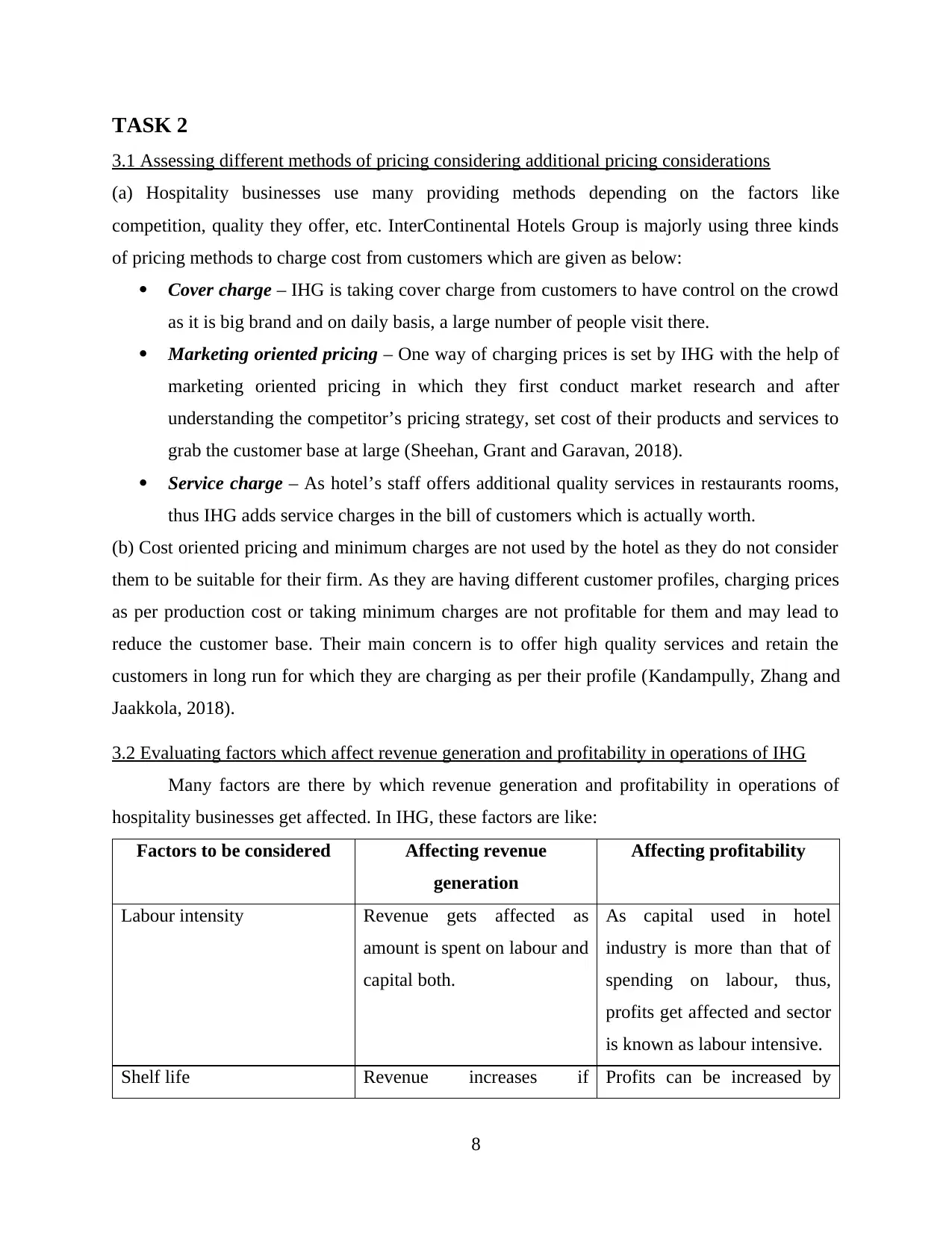
TASK 2
3.1 Assessing different methods of pricing considering additional pricing considerations
(a) Hospitality businesses use many providing methods depending on the factors like
competition, quality they offer, etc. InterContinental Hotels Group is majorly using three kinds
of pricing methods to charge cost from customers which are given as below:
Cover charge – IHG is taking cover charge from customers to have control on the crowd
as it is big brand and on daily basis, a large number of people visit there.
Marketing oriented pricing – One way of charging prices is set by IHG with the help of
marketing oriented pricing in which they first conduct market research and after
understanding the competitor’s pricing strategy, set cost of their products and services to
grab the customer base at large (Sheehan, Grant and Garavan, 2018).
Service charge – As hotel’s staff offers additional quality services in restaurants rooms,
thus IHG adds service charges in the bill of customers which is actually worth.
(b) Cost oriented pricing and minimum charges are not used by the hotel as they do not consider
them to be suitable for their firm. As they are having different customer profiles, charging prices
as per production cost or taking minimum charges are not profitable for them and may lead to
reduce the customer base. Their main concern is to offer high quality services and retain the
customers in long run for which they are charging as per their profile (Kandampully, Zhang and
Jaakkola, 2018).
3.2 Evaluating factors which affect revenue generation and profitability in operations of IHG
Many factors are there by which revenue generation and profitability in operations of
hospitality businesses get affected. In IHG, these factors are like:
Factors to be considered Affecting revenue
generation
Affecting profitability
Labour intensity Revenue gets affected as
amount is spent on labour and
capital both.
As capital used in hotel
industry is more than that of
spending on labour, thus,
profits get affected and sector
is known as labour intensive.
Shelf life Revenue increases if Profits can be increased by
8
3.1 Assessing different methods of pricing considering additional pricing considerations
(a) Hospitality businesses use many providing methods depending on the factors like
competition, quality they offer, etc. InterContinental Hotels Group is majorly using three kinds
of pricing methods to charge cost from customers which are given as below:
Cover charge – IHG is taking cover charge from customers to have control on the crowd
as it is big brand and on daily basis, a large number of people visit there.
Marketing oriented pricing – One way of charging prices is set by IHG with the help of
marketing oriented pricing in which they first conduct market research and after
understanding the competitor’s pricing strategy, set cost of their products and services to
grab the customer base at large (Sheehan, Grant and Garavan, 2018).
Service charge – As hotel’s staff offers additional quality services in restaurants rooms,
thus IHG adds service charges in the bill of customers which is actually worth.
(b) Cost oriented pricing and minimum charges are not used by the hotel as they do not consider
them to be suitable for their firm. As they are having different customer profiles, charging prices
as per production cost or taking minimum charges are not profitable for them and may lead to
reduce the customer base. Their main concern is to offer high quality services and retain the
customers in long run for which they are charging as per their profile (Kandampully, Zhang and
Jaakkola, 2018).
3.2 Evaluating factors which affect revenue generation and profitability in operations of IHG
Many factors are there by which revenue generation and profitability in operations of
hospitality businesses get affected. In IHG, these factors are like:
Factors to be considered Affecting revenue
generation
Affecting profitability
Labour intensity Revenue gets affected as
amount is spent on labour and
capital both.
As capital used in hotel
industry is more than that of
spending on labour, thus,
profits get affected and sector
is known as labour intensive.
Shelf life Revenue increases if Profits can be increased by
8
Paraphrase This Document
Need a fresh take? Get an instant paraphrase of this document with our AI Paraphraser
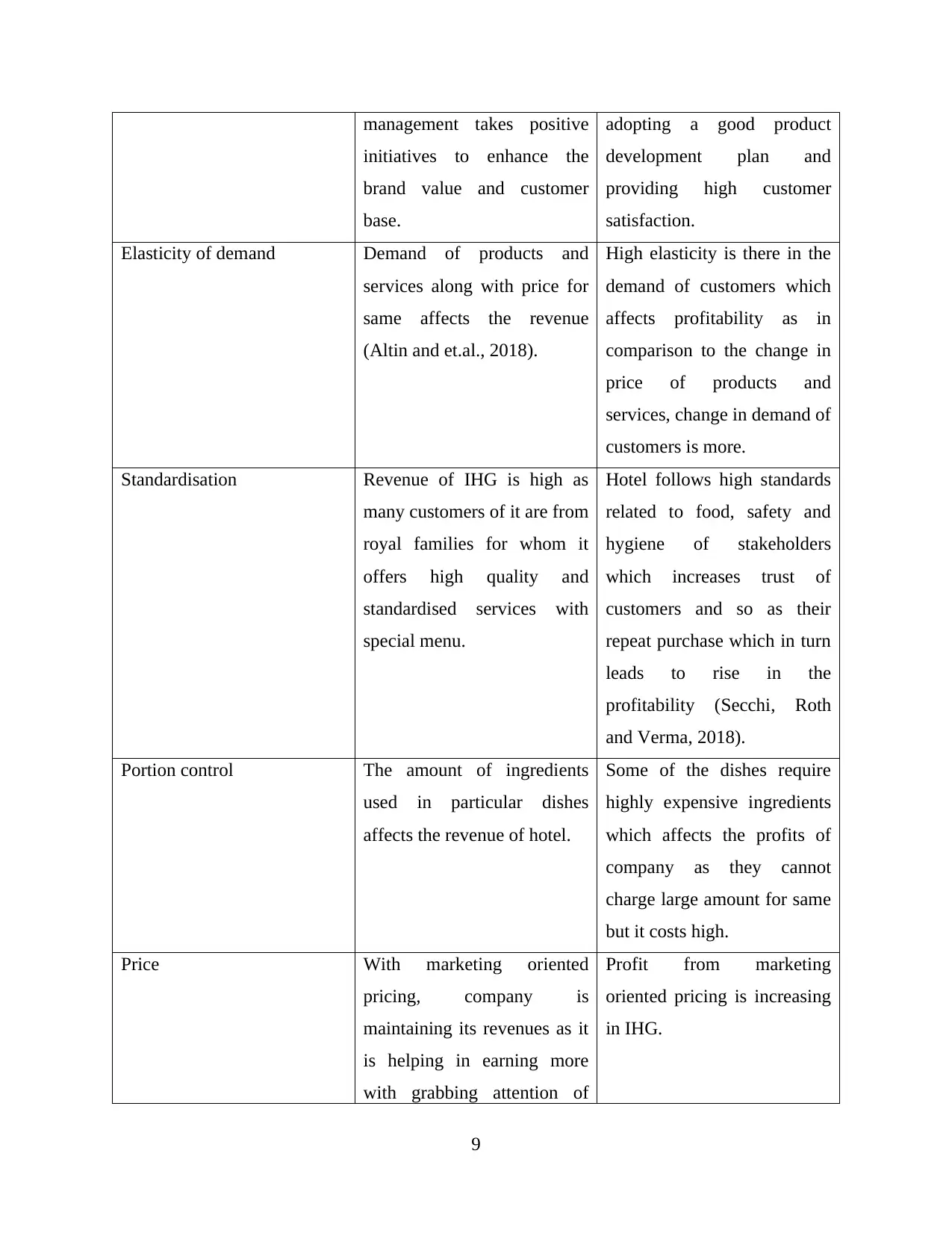
management takes positive
initiatives to enhance the
brand value and customer
base.
adopting a good product
development plan and
providing high customer
satisfaction.
Elasticity of demand Demand of products and
services along with price for
same affects the revenue
(Altin and et.al., 2018).
High elasticity is there in the
demand of customers which
affects profitability as in
comparison to the change in
price of products and
services, change in demand of
customers is more.
Standardisation Revenue of IHG is high as
many customers of it are from
royal families for whom it
offers high quality and
standardised services with
special menu.
Hotel follows high standards
related to food, safety and
hygiene of stakeholders
which increases trust of
customers and so as their
repeat purchase which in turn
leads to rise in the
profitability (Secchi, Roth
and Verma, 2018).
Portion control The amount of ingredients
used in particular dishes
affects the revenue of hotel.
Some of the dishes require
highly expensive ingredients
which affects the profits of
company as they cannot
charge large amount for same
but it costs high.
Price With marketing oriented
pricing, company is
maintaining its revenues as it
is helping in earning more
with grabbing attention of
Profit from marketing
oriented pricing is increasing
in IHG.
9
initiatives to enhance the
brand value and customer
base.
adopting a good product
development plan and
providing high customer
satisfaction.
Elasticity of demand Demand of products and
services along with price for
same affects the revenue
(Altin and et.al., 2018).
High elasticity is there in the
demand of customers which
affects profitability as in
comparison to the change in
price of products and
services, change in demand of
customers is more.
Standardisation Revenue of IHG is high as
many customers of it are from
royal families for whom it
offers high quality and
standardised services with
special menu.
Hotel follows high standards
related to food, safety and
hygiene of stakeholders
which increases trust of
customers and so as their
repeat purchase which in turn
leads to rise in the
profitability (Secchi, Roth
and Verma, 2018).
Portion control The amount of ingredients
used in particular dishes
affects the revenue of hotel.
Some of the dishes require
highly expensive ingredients
which affects the profits of
company as they cannot
charge large amount for same
but it costs high.
Price With marketing oriented
pricing, company is
maintaining its revenues as it
is helping in earning more
with grabbing attention of
Profit from marketing
oriented pricing is increasing
in IHG.
9
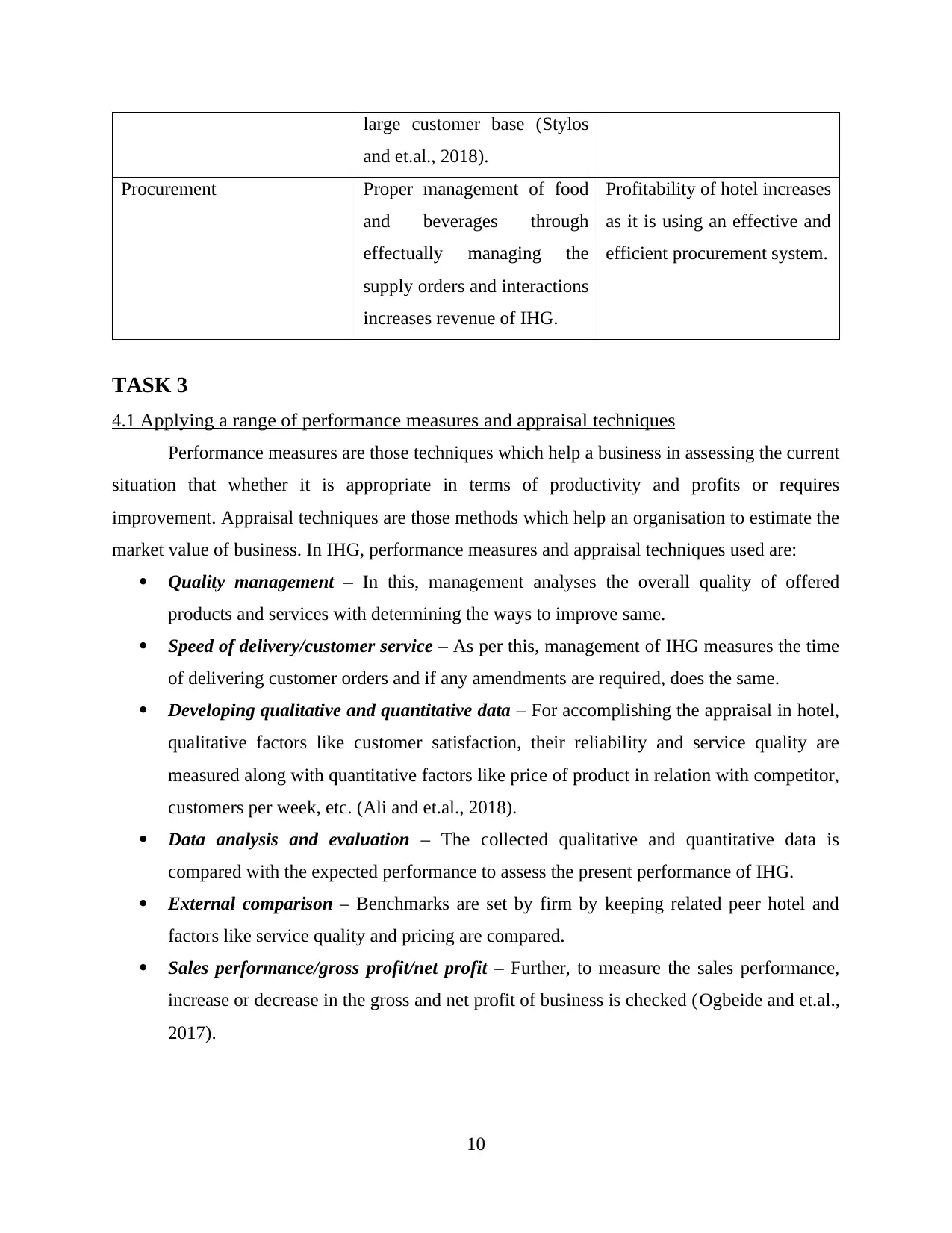
large customer base (Stylos
and et.al., 2018).
Procurement Proper management of food
and beverages through
effectually managing the
supply orders and interactions
increases revenue of IHG.
Profitability of hotel increases
as it is using an effective and
efficient procurement system.
TASK 3
4.1 Applying a range of performance measures and appraisal techniques
Performance measures are those techniques which help a business in assessing the current
situation that whether it is appropriate in terms of productivity and profits or requires
improvement. Appraisal techniques are those methods which help an organisation to estimate the
market value of business. In IHG, performance measures and appraisal techniques used are:
Quality management – In this, management analyses the overall quality of offered
products and services with determining the ways to improve same.
Speed of delivery/customer service – As per this, management of IHG measures the time
of delivering customer orders and if any amendments are required, does the same.
Developing qualitative and quantitative data – For accomplishing the appraisal in hotel,
qualitative factors like customer satisfaction, their reliability and service quality are
measured along with quantitative factors like price of product in relation with competitor,
customers per week, etc. (Ali and et.al., 2018).
Data analysis and evaluation – The collected qualitative and quantitative data is
compared with the expected performance to assess the present performance of IHG.
External comparison – Benchmarks are set by firm by keeping related peer hotel and
factors like service quality and pricing are compared.
Sales performance/gross profit/net profit – Further, to measure the sales performance,
increase or decrease in the gross and net profit of business is checked (Ogbeide and et.al.,
2017).
10
and et.al., 2018).
Procurement Proper management of food
and beverages through
effectually managing the
supply orders and interactions
increases revenue of IHG.
Profitability of hotel increases
as it is using an effective and
efficient procurement system.
TASK 3
4.1 Applying a range of performance measures and appraisal techniques
Performance measures are those techniques which help a business in assessing the current
situation that whether it is appropriate in terms of productivity and profits or requires
improvement. Appraisal techniques are those methods which help an organisation to estimate the
market value of business. In IHG, performance measures and appraisal techniques used are:
Quality management – In this, management analyses the overall quality of offered
products and services with determining the ways to improve same.
Speed of delivery/customer service – As per this, management of IHG measures the time
of delivering customer orders and if any amendments are required, does the same.
Developing qualitative and quantitative data – For accomplishing the appraisal in hotel,
qualitative factors like customer satisfaction, their reliability and service quality are
measured along with quantitative factors like price of product in relation with competitor,
customers per week, etc. (Ali and et.al., 2018).
Data analysis and evaluation – The collected qualitative and quantitative data is
compared with the expected performance to assess the present performance of IHG.
External comparison – Benchmarks are set by firm by keeping related peer hotel and
factors like service quality and pricing are compared.
Sales performance/gross profit/net profit – Further, to measure the sales performance,
increase or decrease in the gross and net profit of business is checked (Ogbeide and et.al.,
2017).
10
⊘ This is a preview!⊘
Do you want full access?
Subscribe today to unlock all pages.

Trusted by 1+ million students worldwide
1 out of 15
Related Documents
Your All-in-One AI-Powered Toolkit for Academic Success.
+13062052269
info@desklib.com
Available 24*7 on WhatsApp / Email
![[object Object]](/_next/static/media/star-bottom.7253800d.svg)
Unlock your academic potential
Copyright © 2020–2025 A2Z Services. All Rights Reserved. Developed and managed by ZUCOL.




